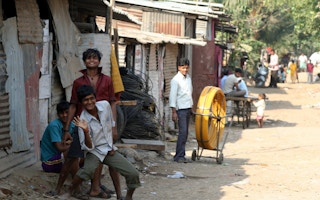The future that fast-growing cities in South Asia and Africa choose—cleaner and safer, or dirtier and more dangerous—will be pivotal to efforts to limit global warming to 1.5 degrees Celsius, scientists said in a key UN report this week.
Iconic metropolises such as New York and London often grab headlines with their plans to cut air pollution, adopt electric transport, design green buildings or protect residents from floods.
But greater efforts are needed to make similar changes in developing-world cities, particularly as many smaller ones lack the knowledge and financial resources to do it, experts said.
“We know that much of urban growth is going to be in these small- and medium-sized cities in the global south,” said William Solecki, an author of the climate science report and professor at Hunter College-City University of New York.
However, “these are cities that historically have had limited capacity in governance and finance,” he said.
Around the world, cities consume more than two-thirds of the world’s energy and account for about three-quarters of carbon dioxide emissions, according to the United Nations.
“
Climate change will impact the most vulnerable, that the capacity to respond will be most limited in those locations and among those peoples.
William Solecki, professor, Hunter College-City University of New York
Whether they can cut those emissions swiftly and protect inhabitants against worsening climate impacts, from flooding to heatwaves, will play a huge role in determining whether the goals of the 2015 Paris Agreement on climate change are met.
But many cities in poorer nations face significant challenges, including large and growing slum populations that lack basic services and are increasingly at risk from climate disasters, experts said.
“The report highlights that climate change will impact the most vulnerable, that the capacity to respond will be most limited in those locations and among those peoples,” Solecki said.
Growing slums
The report from the Intergovernmental Panel on Climate Change outlined ways to hold warming to 1.5 degrees Celsius (2.7 degrees Fahrenheit) above pre-industrial times, and sounded the alarm about the consequences if action to achieve that goal is not stepped up.
The world’s slum population, for instance, is expected to triple to 3 billion by 2050, placing a significant proportion of people “beyond the direct reach” of formal policies to cut emissions and adapt to wild weather and rising seas, it noted.
How to tackle the conditions that lead to informal urban settlements and fuel the risks to their inhabitants “is a central question”, the report said.
Among the problems that need to be addressed, it said, are poverty, weak governance and low levels of investment by local authorities.
On the brighter side, the lack of government services in poorer parts of cities also can spur “green” informal economies, based around things like recycling. Such economies are often low-carbon and use resources efficiently, the report noted.
Bringing low-carbon transitions to slums will require governments teaming up with communities, it said.
But “there is no guarantee that these partnerships will evolve or cohere into the type of service delivery and climate governance system that could steer the change on a scale required to limit to warming to 1.5C”, the report warned.
Still, it acknowledged work by some organisations, such as Shack/Slum Dwellers International (SDI), to try to make that happen.
That non-profit network is collaborating, among other initiatives, on a project in the South African city of Durban to build evidence—in part by having slum communities collect data—on the best ways to upgrade more than 20 informal settlements.
1.5C plans
Mark Watts, executive director of C40 Cities, which promotes climate action in metropolises, said his group was funding advisors for member African cities, to help them put together plans in line with the 1.5C warming goal.
While those cities may lack expertise, they do not have “big negative bureaucracies to push against”, which may make winning the case for low-carbon development easier, he said.
They also can “leapfrog the mistakes made by the West”, he added.
An African city that lacks a waste management system, for instance, can build modern treatment plants that run on clean energy, rather than trying to fix or improve older facilities.
Watts urged cities to stop investing in infrastructure—including roads—that is likely to hike carbon emissions in future.
Instead they should put scarce resources into clean transport, zero-carbon buildings and training people to deliver green infrastructure, he said.
Seven cities that are members of C40—New York, Barcelona, Copenhagen, London, Oslo, Paris and Stockholm— have already published climate change strategies designed to deliver on the 1.5C goal, and a further 65 have committed to do so.
But most cities are still developing in an unsustainable way that is adding to carbon emissions, Watts said.
The 1.5C report made clear what cities must do to become green and resilient, and the urgency of following that path, he noted.
“The cities that don’t change won’t be viable in a few decades’ time,” he warned.
This story was published with permission from Thomson Reuters Foundation, the charitable arm of Thomson Reuters, that covers humanitarian news, climate change, resilience, women’s rights, trafficking and property rights. Visit http://news.trust.org/climate.










